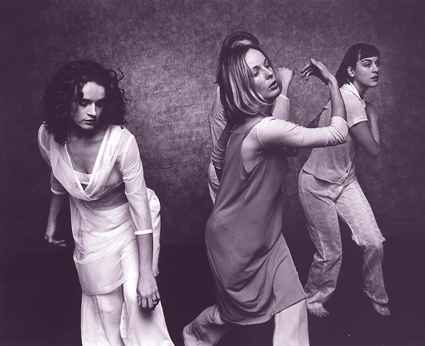Between perceptual fields
Philipa Rothfield, DW98, Dance Works

Carlee Mellow, Rachel Roberts, Joanna Lloyd (hidden), Belinda Cooper, Live Opera Situation, DW98
According to Gestalt psychology, every perception always involves a figure and a background. At any moment, a perceptual foreground may be in focus whilst its background isn’t, and vice versa. We, as perceivers, actively focus upon the objects of our experience. In order to do so, inevitably, other objects fall out of focus. One of the famed examples of Gestalt psychology is a drawing of a shape—looked at in one way that shape is a cube; observed in another way, it becomes a square with lines emanating from its corners. The three pieces of Dance Works’ 98 season variously evoked Gestalt’s perceptual divide, here a split between the abstract and the real.
The first piece, Waiting (choreographer Sandra Parker), progressed from the real to an increasingly abstract terrain. Perhaps inspired by the snippet from Romeo and Juliet quoted in the program notes, Waiting opened with lots of getting up and down, posing, pausing and stillness spilling into motion. At first, I wondered at the meaning of all this. Then it struck me—the unforgiving temporality of yearning, waiting (“…so tedious is this day/As is the night before some festival/To an impatient child that hath new robes/And may not wear them…”).
Rather than evoke a recognisable lexicon of emotion (not to forget Umberto Eco’s claim that “I love you” is so trite a statement that it is now emptied of all meaning), Parker chose to illuminate her theme in much more abstract terms. Having acknowledged the plane of representation as non-literal, I found the kinetic landscape of Waiting became increasingly surreal. This peaked for me where one dancer occupied the middle of a rather Gothic looking scene—a dark red, barely lit, former church with a tilting floor—while three others moved underneath a stone window lit in silhouette, and a fourth pensively roamed an antechamber. At that point, my perception flipped and the space became a mind, populated by columns and bodies, the connections between dancers, neural synapses. It is not clear to me whether the 5 dancers were one entity, facets of the one entity or more than one being. Nor, ultimately, do I know what happened. What interested me about the piece was the way in which my perception shifted gears away from the real, and further and further into an imaginary landscape.
Live Opera Situation choreographed by Shelley Lasica followed suit in its allegiance to the abstract. The motivating premise of the piece was articulated pretty clearly in the program notes: this is a work exploring the ways in which 4 “voices” work together and separately, as in operatic forms. The juxtaposition of choreographic difference was asserted throughout the piece, emphasised by costuming, music and a surprising array of gestures. Although much of the movement had the mark of Lasica’s distinctive corporeality, the dancers were given very divergent tasks. Various fronts were assumed, sometimes implying interaction, sometimes not.
If there was harmony to be found between the 4 elements (dancers) it was not represented by repetition or similarities of movement. Any sense of harmony or coherence had to be built upon difference rather than erasing it. Over time, it did seem that a certain unity was forming, partly achieved by an interaction between the dancers who, increasingly, constituted a kinetic and spatial intertwining. I also think it was an effect of having experienced this piece over time. Like those 3D computer graphics, letting go of a narrow focus allows other elements to come into play. What might initially be perceived as pure heterogeneity is able to become something else. Is that what harmony is, a set of differences perceived as a whole?
After Waiting and Live Opera Situation, I found the very grounded nature of Sue Healey’s Stung difficult to take in. I was stuck in the abstract register of the first two pieces, whereas this one required a somewhat different appreciation. Not everyone seems to have shared my difficulties. Some who didn’t like the first two pieces found Stung a welcome relief. They laughed at its humour and earthy subject matter. Darrin Verhagen’s music also cited familiar rhythms and recognisable allusions.
A work about the life and times of the bee, Stung also touched on bee sociality. Although the work was not simply direct representation of bee-hood, its strongest moments for me were in its most literal references—to the swarm, and to bees crawling over honeycomb. Some of the movements had a sensual delight about them, the best being a bee solo of wiggled hips and curled arms. Spatial coverage and speed were used more consistently in this piece than the others, suggesting elements of design within Healey’s choreographic vision.
I am quite struck by the divide which seems to have applied to the appreciation of these three pieces. It seems that the perception of the first two works required something quite distinct from what was required of the third. The variety of views here, in conjunction with the heterogeneity of values manifest in the MAP Symposium, just goes to show the inadequacy of the response “it was/was not good” (a banality I myself have been using for years). When we judge a work, we speak not only about the object of our judgement, but about the subject who judges.
–
DW98, Dance Works: Waiting, choreographer Sandra Parker, composer Lawrence Harvey, costumes Adrienne Chisholm, dancers Belinda Cooper, Joanna Lloyd, Carlee Mellow, Rachel Roberts, Sally Smith; Live Opera Situation, choreographer Shelley Lasica, composer Franc Tétaz, costume coordinator Shelley Lasica, dancers Belinda Cooper, Joanna Lloyd, Carlee Mellow and Rachel Roberts; Stung, choreographer Sue Healey, composer Darrin Verhagen, costumes Adrienne Chisholm, dancers Belinda Cooper, Joanna Lloyd, Carlee Mellow, Rachel Roberts, Sally Smith; Wesleyan Hall, Albert Park, July 15 – July 26
RealTime issue #27 Oct-Nov 1998 pg. 6






